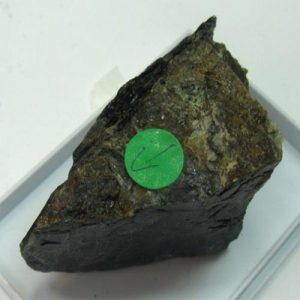Polycrase-(Y)
Polycrase-(Y) is a very rare radioactive mineral that belongs to the Polycrase Group of minerals that includes Euxenite-(Y), Polycrase-(Y) and Yttrocrasite-(Y). Because of the rare earth metals in its structure, Polycrase-(Y) is one of several minerals called “Rare Earth Oxides”. Other rare earth oxides such as Aeschynite, Fergusonite and Samarskite have very similar properties to Polycrase-(Y) and are often associated with each other. Faceted Polycrase-(Y) gems are extremely rare and really only faceted as a collector’s oddity. The chemical formula of Polycrase is (Y,Ca,Ce,U,Th)(Ti,Nb,Ta)2O6 (Yttrium Calcium Cerium Thorium Niobium Tantalum Oxide) and its molecular weight is 372.96 gm. Polycrase-(Y) is a strongly radioactive mineral and should be stored away from other gems and minerals that are subject to damage from radioactivity and of course human exposure should be limited!
Less common than euxenite. Polycrase has a specific gravity of 4.70 – 5.90 (g/cm3); may be less when altered and the refractive index of 2.250 Isotropic. Some localities for well-characterized material include: from Rasvåg, Hidra (Hitterö) Island, near Flekkefjord, and many other places in Norway. At Slättåkra, Län Jönköping, Sweden. In Lyndoch Township, and about eight km south of Maberly, Ontario, Canada. In the USA, from Zirconia, Henderson County, North Carolina; at Marietta, Greenville County, South Carolina; in the Overlook quarry, Day, Saratoga County, New York; from the Trout Creek Pass pegmatite district, in Park County, east of Buena Vista, Colorado; at the Baringer Hill pegmatite, 26 km west of Burnet, Llano County, Texas. From Santa Clara, near Tocantins, Minas Gerais, Brazil. At Cooglegong, Western Australia. Probably from many places in Madagascar but analyses are lacking for the distinction from abundant euxenite.
| Chemical Formula: | (Y,Ca,Ce,U,Th)(Ti,Nb,Ta)2O6 |
| Yttrium Calcium Cerium Thorium Niobium Tantalum Oxide | |
| Molecular Weight: | 372.96 gm |
| Composition: | Calcium | 1.07 % | Ca | 1.50 % | CaO |
| Cerium | 3.76 % | Ce | 4.40 % | Ce2O3 | |
| Yttrium | 11.92 % | Y | 15.14 % | Y2O | |
| Thorium | 6.22 % | Th | 7.08 % | ThO2 | |
| Uranium | 6.38 % | U | 7.67 % | UO3 | |
| Tantalum | 14.56 % | Ta | 17.77 % | Ta2O5 | |
| Titanium | 15.41 % | Ti | 25.70 % | TiO2 | |
| Niobium | 14.95 % | Nb | 21.38 % | Nb2O5 | |
| Oxygen | 25.74 % | O | |||
| 100.00 % | 100.00 % | = TOTAL OXIDE | |||
| Crystallography: | Orthorhombic – Dipyramidal; commonly Metamict (Amorphous) |
| Crystal Habit: | Crystals are stout prismatic || [001], typically flattened on {010}, may be striated || [001] by twinning, to 5 cm; commonly in parallel to radiating aggregates; massive. |
| Twinning: | Common on {201}; rare on {101} or {013} |
| Cleavage: | None |
| Fracture: | Conchoidal to Subconchoidal |
| Tenacity: | Brittle |
| Moh’s Hardness: | 5.5 – 6.5 |
| Density: | 4.70 – 5.90 (g/cm3); may be less when altered |
| Luminescence: | None |
| Radioactivity: | Strong; GRapi = 603,860.75 (Gamma Ray American Petroleum Institute Units) |
| Color: | Black, Brownish Black, Greenish Black; Brown to Yellow-Brown in transmitted light |
| Transparency: | Opaque, transparent in thin fragments |
| Luster: | Brilliant Submetallic, Waxy to Resinous on fractures |
| Refractive Index: | 2.250 Isotropic |
| Birefringence: | 0.00 (Isotropic) |
| Dispersion: | n/a |
| Pleochroism: | None |


